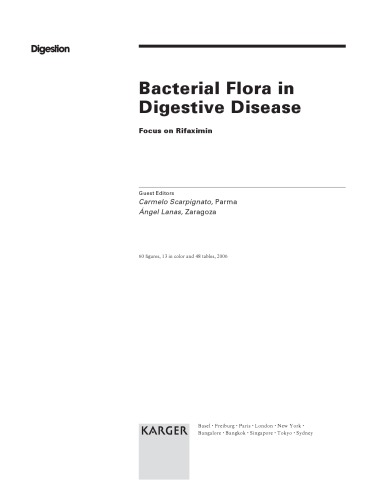

Most ebook files are in PDF format, so you can easily read them using various software such as Foxit Reader or directly on the Google Chrome browser.
Some ebook files are released by publishers in other formats such as .awz, .mobi, .epub, .fb2, etc. You may need to install specific software to read these formats on mobile/PC, such as Calibre.
Please read the tutorial at this link: https://ebookbell.com/faq
We offer FREE conversion to the popular formats you request; however, this may take some time. Therefore, right after payment, please email us, and we will try to provide the service as quickly as possible.
For some exceptional file formats or broken links (if any), please refrain from opening any disputes. Instead, email us first, and we will try to assist within a maximum of 6 hours.
EbookBell Team

4.4
82 reviews 
ISBN 10: 3805580835
ISBN 13: 978-3805580830
Author: C. Scarpignato, A. Lanas
Hundreds of bacterial species make up human gut flora. The intestine has at least 400 different species of bacteria totaling over 1012 organisms. Of these, 99% are anaerobic bacteria. The gastrointestinal tract is then exposed to countless numbers of bacterial species and foreign antigens and has embedded a unique and complex network of immunological and non-immunological mechanisms to protect the host from potentially harmful pathogens. Healthy individuals are generally tolerant to their own microbiota, but such tolerance is impaired in patients with both organic and functional gastrointestinal diseases. The advancement of the knowledge on microbial-gut interactions in health and disease has allowed a more pathophysiologically-oriented approach to several challenging clinical conditions. There are currently two ways to manipulate enteric flora. Antibiotics can selectively decrease tissue invasion and eliminate aggressive bacterial species or globally decrease luminal and mucosal bacterial concentrations, depending on their spectrum of activity. Alternatively, administration of beneficial bacterial species (probiotics), poorly absorbed dietary oligosaccharides (prebiotics), or combined probiotics and prebiotics (synbiotics) can restore a predominance of beneficial commensal flora. These two therapeutic approaches are not, of course, mutually exclusive. Rifaximin, a poorly absorbed antibiotic targeted at the gastrointestinal tract, has been long used in Italy for the treatment of infectious diarrhea in both adults and children. During the past few years the appreciation of the pathogenic role of gut bacteria in several organic and functional gastrointestinal diseases has increasingly broadened its clinical use, which now covers hepatic encephalopathy, small intestine bacterial overgrowth, inflammatory bowel disease and colonic diverticular disease. Other potential clinical indications are being explored and look promising.
Foreword
Preface
Enteric Flora in Health and Disease
Experimental and Clinical Pharmacology of Rifaximin a Gastrointestinal Selective Antibiotic
Pharmacological Treatment of the Irritable Bowel Syndrome and Other Functional Bowel Disorders
Is There Room for Antibiotics?
Pathophysiology and Clinical Picture
Management of Colonic Diverticular Disease
Current Therapeutic Options
Antimicrobials in the Management of Inflammatory Bowel Disease
From Pathophysiology to Treatment
Focus on Antibiotic Therapy
Epidemiology Etiology and Pathophysiology of Travelers Diarrhea
Prevention and Treatment of Travelers Diarrhea
Treatment Options
Are RifaximinBased Regimens Effective?
A Role for Antibiotics?
Author Index
Subject Index
bacterial flora in digestive disease
bacterial flora digestive system
bacterial flora in large intestine
bacterial flora in large intestine help with
bacterial flora large intestine function
Tags: C Scarpignato, A Lanas, Bacterial, Flora, Digestive, Disease, Rifaximin